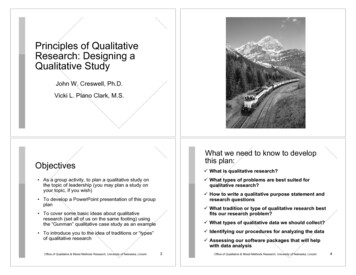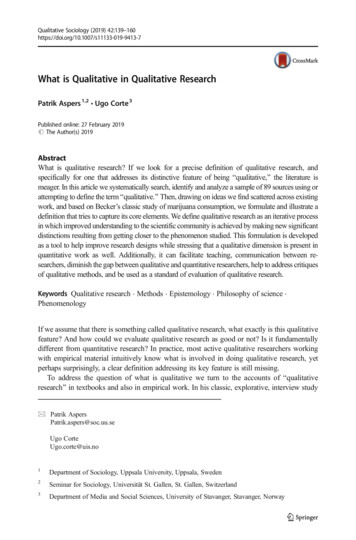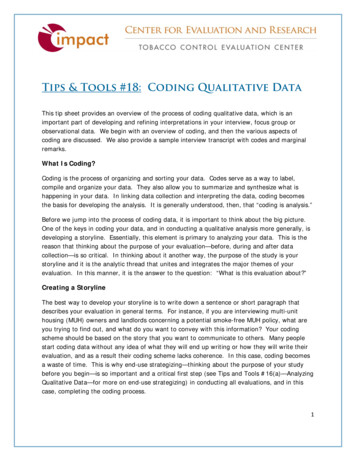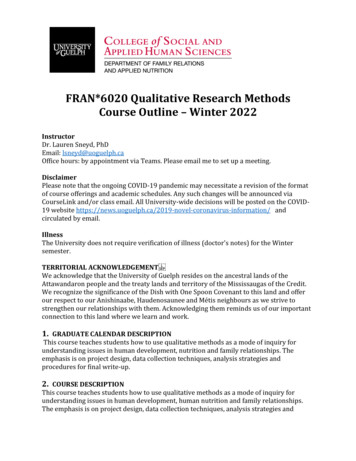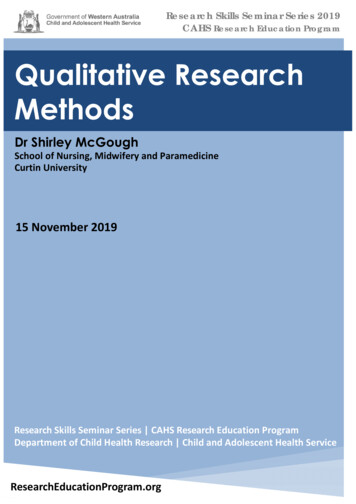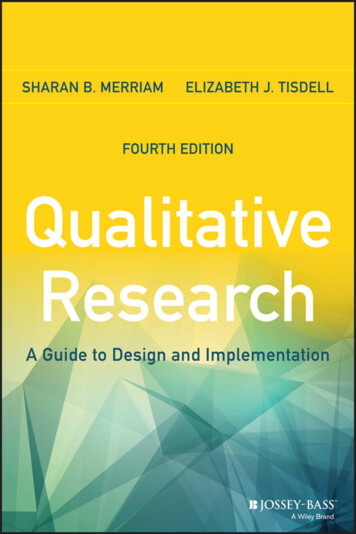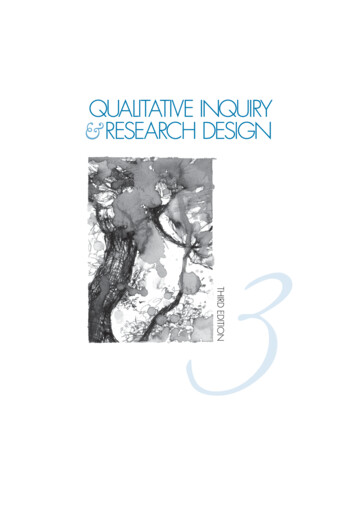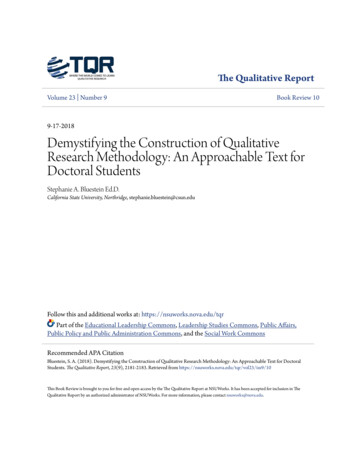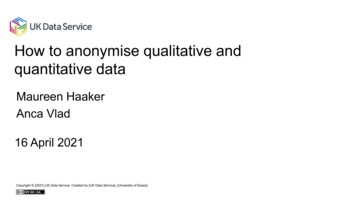
Transcription
How to anonymise qualitative andquantitative dataMaureen HaakerAnca Vlad16 April 2021Copyright [2021] UK Data Service. Created by [UK Data Service], [University of Essex]
Overview Introduction: Why anonymise? A very short introduction to anonymisation theory Anonymisation or Pseudonymisation? Access restrictions Exercise 4 steps to anonymisation A couple considerations for qualitative data Exercises: de-identification Further resources and questions
What is disclosure? Why do we needanonymisation? Disclosure identification Disclosure happens when someone is able to identify a data subject from data orinformation they have access to from one source or multiple sources. Different types of disclosure: identity, attribute, inferential Anonymisation is a process that attempts to prevent disclosure or identification of datasubjects from a specific dataset Anonymisation and pseudonymisation is part of Statistical Disclosure Control (SDC): theaim of SDC is to minimise/mitigate the risk of identification to an acceptable level that stillallows researchers to maximise data use (use the data to it’s full potential or as close to itas possible) When disclosure riskinformation loss
Anonymisation theoryData situationauditRisk analysisand controlImpactmanagement
Legal obligations,or when you need to break confidentiality
Anonymisation / PseudonymisationAnonymised data: '.information which does not relate to an identified or identifiable natural person or topersonal data rendered anonymous in such a manner that the data subject is not or nolonger identifiable.'' (Recital 26, GDPR) Cannot re-identify data subjects (even the data owner)Pseudonymised data: “ the processing of personal data in such a manner that the personal data can no longerbe attributed to a specific data subject without the use of additional information, providedthat such additional information is kept separately and is subject to technical andorganisational measures to ensure that the personal data are not attributed to an identifiedor identifiable natural person.” (Article 4, GDPR) Identifiable data has been removed or redacted so that cannot be traced back to the realvalues. Re-identification of data can only be achieved with knowledge of the deidentification key or by combination.
Anonymisation / Pseudonymisation ICO: ‘re-identification’: describes the process of turning anonymised databack into personal data through the use of data matching or similartechniques. The DPA does not prohibit the disclosure of personal data, but any disclosurehas to be fair, lawful and in compliance with data protection principles. To consider: the age of the information (less sensitive over time, but consider ethical) level of detail context: private life or about more public matters, such as their working life, orlife satisfaction? Rule of thumb: try to assess the effect – if any - that the disclosure would haveon any individual concerned
Anonymisation / seudonymisedData utilityAccess controlsInformation LossAnonymised
Data governance, managing access to dataOpenSafeguardedControlled available for download / online access to logged-in users who have registeredand agreed to an End User Licence (eg. not identify any potentially identifiableindividuals) special agreements (depositor permission; approved researcher) embargo for fixed time period available for remote or safe room access to authorised and authenticatedusers whose research proposal has been and who have received training
UKDS data management guidance Best practice guidance:www.ukdataservice.ac.uk/managedata.aspx Managing and Sharing ResearchData – a Guide to GoodPractice:(Sage Publications Ltd) ents Twitter: @UKDSRDM
Classifying information (variables)A. Identifying variables1. Direct identifiers - information that directly identifies data subjects- examples: social insurance number, names, address,national insurance number, IP address etc.2. Key identifiers - information that in combination, may uniquely identify data subjects;- can potentially be linked to other sources of data as well (such as the electoralregister)- examples: gender, age, region, occupation, incomeB. Sensitive variables - information that is often subject to legal and ethical concerns;- examples: criminal history, sexual preferences and behaviour, politicalaffiliations, medical records, income- can lead to attribute disclosure even if identity disclosure is prevented.One variable can be both identifying and sensitive. Example: income.You are not so anonymous!
Anonymisation, Step 1Similar for both quantitative and qualitative data, the first step is always toidentify and remove or redact identifying information (direct identifiers). Easier for quantitative data - removal of variables Can vary for qualitative data replace with pseudonyms or not redact out
Anonymisation Quantitative Data (Step 2) Identify all indirect identifiers: Age/Date of Birth Gender Occupation Income Geography (area/county/city/village etc.) Ethnic Background/Ethnicity Religion Note here how important good quality metadata can be for this process(variable labels, value labels).
Anonymisation Quantitative Data (Step 3) Look at frequencies in the data to identify potentially disclosiveinformation. Look at outliers. Look at string variables (other open text) to identify if they containany personal, potentially disclosive or sensitive information (“Iworked for X company for 30 years” or “my brother has a rare typeof disease” or “I was a victim of domestic abuse and I used charityx for support”) Introduction to Statistical Disclosure Review
Anonymising quantitative data: some tips Aggregate or reduce the precision;Recode categorical key variables into fewer categories (k-anonymity)Suppressing specific values of key variables for some units (k-anonymity)Generalise meaning of text variables - replace potentially disclosive free-textresponses with more general text Restrict the upper or lower ranges of a continues variable to hide outliers E.g age – recode into 70 How to decide? Look at distribution of that variable. Anonymise geo-referenced data - replacing point coordinates with nondisclose variables
Useful software sdcMicro – R package (free) – has a user friendly interface so minimal codingskills needed. QAMyData - UK Data Service developed a free (GitHub) easy-to-use opensource tool, that provides a health check for numeric data. The tool usesautomated methods to detect and report on some of the most common problemsin survey or numeric data, such as missingness, duplication, outliers and directidentifiers. ARX - a comprehensive open source software for anonymizing sensitive personaldata. It supports a wide variety of (1) privacy and risk models, (2) methods fortransforming data and (3) methods for analysing the usefulness of output data. µ-Argus – developed by Statistics Netherlands; User Manual Text anonymization helper tool: Tool to help find disclosive information in textualfiles. The tool does not anonymize or make changes to data, but uses MS Wordmacros to find and highlight numbers and words starting with capital letters intext.
Anonymising qualitative data: some tips Plan or apply editing at time of transcriptionExcept: longitudinal studies - (linkages) Consistency within research team and throughout project Identify replacements, e.g. with [brackets] Keep anonymisation log of all replacements, aggregations or removalsmade – keep separate from anonymised data files Avoid blanking out; use pseudonyms or replacements Avoid over-anonymising - removing/aggregating information in text candistort data, make them unusable, unreliable or misleadingControlling access a better option than over-anonymising
In practice: example anonymisation
In practice:wording in consent forms / information sheetsWe expect to use your contributed information in various outputs, includinga report and content for a website. Extracts of interviews and somephotographs may both be used. We will get your permission before using aquote from you or a photograph of you.After the project has ended, we intend to archive the interviews at . Thenthe interview data can be disseminated for reuse by other researchers, forresearch and learning purposes.
In practice: data with access conditions Health and Social Consequences of the Foot and Mouth DiseaseEpidemic in North Cumbria, 2001-2003 (study 5407 in UK Data Archivecollection) by M. Mort, Lancaster University, Institute for Health Research. Interviews (audio and transcript) and written diaries with 54 people 40 interview and diary transcripts are archived and available for re-use byregistered users3 interviews and 5 diaries were embargoed until 2015audio files archived and only available by permission from ?sn 07userguide.pdf
In practice: Pioneers of Social ResearchConducted by pioneering oral historian, Paul Thompson and his colleagues, this collectioncontains 43 life story interviews with pioneering social researchers, covering family andsocial background and key influences with detailed accounts of major projects.
In practice: Managing Suffering at the End of LifeSome dying people experiencesymptoms in the last hours or days oflife that do not respond well toconventional therapies. In suchcircumstances, sedation may be givento induce a coma until death occurs.This practice is known as 'continuousdeep sedation until death' or as'palliative' or 'terminal' sedation. Thesedata describe the care of dying peoplewith refractory symptoms and includesensitive issues such as balancingsymptom control with avoidance ofhastening death.
In practice: anonymisation plans Project background File management Mandatory anonymisation Direct Identifiers (names, contact details) Places Ages and dates Possible anonymisation Medical information about others not taking part in study Sensitive information (unfavourable opinions of others, details of legal cases, etc.)
3-prong approach to protecting participants:Consent, anonymisation, and access Ask for consent to share –researchers must be informed about risks andbenefits of data sharing Anonymise – only if damage to data is minimal (not images) Regulate access End User Agreement (UK Data Archive) Embargo For selected sensitive or disclosive data – registered users; permissionfrom data depositorThese strategies enable most data to be shared.
Exercise 1De-identification of quantitative cise deidentify quant data.pdf
Exercise 2De-identification of qualitative cise de-identify quali data.pdf
Tools and templates Model consent amodelconsent.pdf Survey consent dasurveyconsent.doc Transcription amodeltranscript.pdf Transcription instructions: transcriptioninstructions.pdf Transcription confidentiality da-transcriberconfidentialityagreement.pdf Data list Data%20Archive%20Example%20Data%20List.pdf
Further resources Anonymising Research Data - ESRC National Centre forResearch Methods, Working Paper 7/06 Guide to Social Science Preparation and Archiving from theInter-University Consortium for Political and Social Research Anonymisation and Social Research, Ruth Geraghty Timescapes anonymisation guidelines, University of Leeds Anonymisation: managing data protection risk - ICO code ofpractice The Anonymisation Decision-Making Framework - Mark Elliot,Elaine Mackey Kieron O'Hara and Caroline Tudor Jisc guidance on anonymous data Advice from med.data.edu on anonymisation
Upcoming eventsWebinars and workshops 22 April, 11-12:30: Getting started with Secondary Analysis (online)29 April, 11-12:00: Data Management Basics 1: Introduction to data management and sharing30 April, 10-11: Data Management Basics 2: Ethical and legal issues in data sharing18 May, 11-12:30: Dissertation projects: introduction to secondary analysis for qualitative andquantitative data 27 May, 10-11: Consent issues in data sharingOther training 27 April, 6-7:30 pm: PyDataMCR – Data FAQs with the UK Data Service28 April: Safe Researcher Training (online)19-20 May: Introduction to Understanding Society using Stat/SPSS/R/SAS (University of Essex)21 May: Panel data econometrics using Understanding Society (University of Essex)12-16 July: Essex Summer School
Get ?A0 CE.Check out our Twitter for more updates.
QuestionsEnquiries / Help rvice.ac.uk
Anonymising qualitative data: some tips Plan or apply editing at time of transcription Except: longitudinal studies - (linkages) Consistency within research team and throughout project Identify replacements, e.g. with [brackets] Keep anonymisation log of all replacements, aggregations or removals
